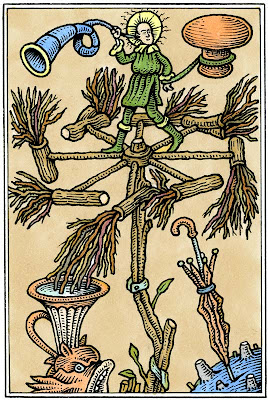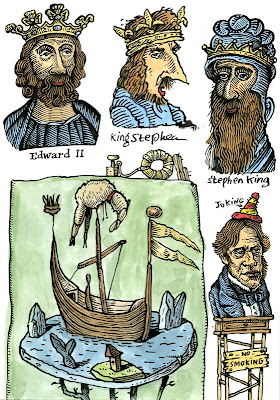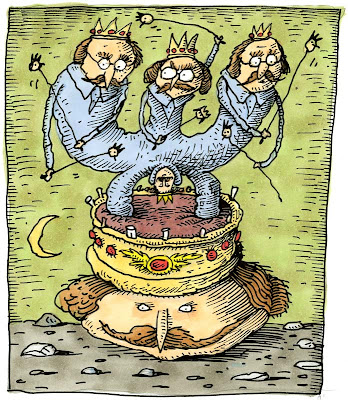 Card no.8 in the current series.
Card no.8 in the current series.
Copic markers and Staedtler fineliners. 12cm x 8cm. Click to enlarge.
Viewing: Blog Posts Tagged with: Main Page, Most Recent at Top [Help]
Results 1 - 7 of 7
Blog: Ellis Nadler's Sketchbook (Login to Add to MyJacketFlap)
JacketFlap tags: machine, mouth, Nadler, fish, markers, sculpture, wheels, tree, religion, animals, people, ink, pen, fish, machine, markers, sculpture, mouth, Nadler, wheels, Add a tag
Blog: Ellis Nadler's Sketchbook (Login to Add to MyJacketFlap)
JacketFlap tags: Nadler, wash, boat, markers, hat, sculpture, England, transport, beard, nose, beard, transport, watercolour, ink, whale, England, markers, sculpture, Nadler, dog, animals, people, portrait, boat, wash, nose, words, pen, hat, Add a tag
 Four kings and a royal barge.
Four kings and a royal barge.
Copic markers and watercolour with pen and ink on bristol board. A5 size. Click to enlarge.
Blog: Ellis Nadler's Sketchbook (Login to Add to MyJacketFlap)
JacketFlap tags: Nadler, glasses, markers, hat, psychology, beard, nose, people, cartoon, ink, psychology, markers, beard, hat, Nadler, nose, glasses, pen, Add a tag
 A variant on previous post, trying different materials.
A variant on previous post, trying different materials.
Copic markers and Lamy pen with Noodlers ink on Bristol Board. 11cm x 12.5cm. Click to enlarge.
Blog: Monday Artday (Login to Add to MyJacketFlap)
JacketFlap tags: markers, favorite book, Add a tag

This piece was done by my 5 year old daughter. Her favorite book is Horns and Wrinkles by Joseph Helgerson and Nicoletta Ceccoli. This picture is of the Old Lady who is actually a fairy.
It's done in marker.
Blog: ballparkfigures (Login to Add to MyJacketFlap)
JacketFlap tags: Main Page, Main Page, Add a tag
Or rather a squirrel, called Hudson.
So this is it: the start of Book Two. From now on the ballparkfigures blog will be replacing the ‘MAKING OF’ section on my website. The main aim here is to try and document a little of what goes into making a book. ( bandwidth withstanding ) Or rather to highlight certain aspects of the process which are close to my heart. Of course this could all just be the best excuse for prevaricating I’ve come up with so far. But who knows? I guess we’ll find out together.
At some point the flow of information is bound to slow down, after all there’s a book to be done as well. Also the sequel to Moonbox is packed with all sorts of secrets and surprises, and I may have to stop altogether if I feel that I’m giving too much away. Dammit! I really shouldn’t have said that.
Just from getting the artwork together for this first entry it seems inevitable that many of the things posted here will be subject to change over the coming weeks and may even be dropped from the final book. Who knows in a few months time I might even be saying “Squirrel, what squirrel? I think you‘ll find that Book Two starts with a beaver called Cavendish!”
Frankly the way I work is a little odd at times and rarely flows in a linear fashion. ( such as initial ideas, sketching, finished artwork. ) It’s something I’m endlessly trying to amend, but rarely with any real success. Computers have opened up a whole new world of endless revision, and I expect this project to be no different. I’m sure you can look forward to all sorts of major meltdowns in the future before things start coming together in any sensible fashion.
Somehow with Book Two I’ve managed to sidestep the whole agony of knowing just how to start it. Although this is probably due to the fact that I’ve had the last five years to think about the opening. Of course with any story there are countless ways of making the same point. With a sequel however it does seem incumbent on the author to tease the audience a little bit more in order to balance out the weight of expectation. So rather than give them what they may or may not want, give them something they couldn’t expect. And yes by this I do mean a squirrel.
And so to the work. The first major task is to lockdown the actual design of Hudson, followed by his home; and then the area of the forest he lives in/immediate surroundings. So let’s start with Hudson himself.

This was my first real attempt at defining the little critter. I’m particularly happy with the drawing at top right and some version of this may well end up in the finished book. It has to be said that the whole mood of warmth and comfort was heavily inspired by the last picture in "I AM A BUNNY" by Richard Scarry and Ole Risom.

Unfortunately I’ve gone way past the point where I could ever be satisfied with just drawing any old squirrel for the finished book. For the record Hudson is a North American Red. And while I’m not about to start writing a thesis on the subject I would like his appearance and behaviour to have a solid grounding in the species. Now you may think that this is a little nuts. After all what difference does it make? A squirrel’s a squirrel, right? Well no. The possibilities to say things through the subtleties of characterisation, are endless, and I want to explore them fully.

Oh the humanity! Please understand that these last two images of Hudson appear before you only in the spirit of full disclosure. As such they represent the first ill-fated attempt at modelling Hudson in 3D. Looking at it now everything seems hopelessly wrong: body too short; legs too big; arms too long, and neck too thin. Although on the plus side I do quite like the cartoon simplicity of the eyes, nose and mouth; especially in profile. Unfortunately I tried animating him and it turned out awful; like some strange confused humanoid wandering around with a squirrel’s head. It’s funny because this is exactly the look and feel I was trying so hard to avoid. I can’t stand it when cg characters cross the line into total anthropomorphism, loosing all sense of the creature they were supposed to be in the first place.
So basically this went wrong because I only had a few sketches to work from, and not a proper character sheet with all the different proportions and markings worked out well in advance. Let that be a lesson to me. It’s horrible to be made aware of your shortcomings in this way, but good to know that you’re intent on correcting the problem, rather than pushing it to one side.
So hooray for me, and back to the drawing board.![]()
Blog: Picture Bookies Showcase (Login to Add to MyJacketFlap)
JacketFlap tags: shhhh, brush, agy wilson, children, kids, hedgehog, markers, asleep, Add a tag
Blog: OUPblog (Login to Add to MyJacketFlap)
JacketFlap tags: blog, Health, Education, Science, Current Events, oxford, mondays, stress, autism, A-Featured, Medical Mondays, Psychology, behavioral, subtypes, anxiety, arousal, markers, disorder, coping, medical, Add a tag
Autism confounds researchers but one way of understanding it is to look through the lens of stress and coping. That is exactly what editors M. Grace Baron, June Groden, Gerald Groden and Lewis P. Lipsitt do in their book Stress and Coping in Autism. Contributions by researchers, clinicians, teachers, and persons living with autism illustrate how it is possible to reduce the impact of stress in autism by understanding both the science and the experience of it. Below we excerpt part of the introduction. To learn more be sure to visit our morning post, Helping Children With Autism Learn.
The construct of stress has expanded our understanding of both typical and atypical human development in a revolutionary way. Research into a number of disorders that are  often comorbid with a diagnosis of autism, such as anxiety, shyness, phobias, obsessive-compulsive disorder (OCD), and thought disorder, already include a systematic theoretical and applied analysis of the contribution of stress to the disorder. Autism, in its own right, might also benefit from such a focus for a number of reasons.
often comorbid with a diagnosis of autism, such as anxiety, shyness, phobias, obsessive-compulsive disorder (OCD), and thought disorder, already include a systematic theoretical and applied analysis of the contribution of stress to the disorder. Autism, in its own right, might also benefit from such a focus for a number of reasons.
Anxiety, an indicator that someone is experiencing stress, was associated with autism as early as Kanner’s (1943) first description of the syndrome. A few early clinical and research reports (e.g., Marks, 1987; Matson & Love, 1990) examined the correlation between fear and anxiety and autism. In 1994, Groden, Cautela, Prince, and Berryman presented the first systematic framework for using the concepts of stress and anxiety to describe and treat autism and proposed that those with autism may, in fact, have a special vulnerability to stress. We now have a better understanding that the clinical problems often associated with stress, such as anxiety, are more prevalent among people with pervasive developmental disabilities than in the general population.
Autism has long been seen as a problem of faulty or different arousal responses to environmental intrusions (Dawson & Levy, 1989). This has given rise to continued speculation about the role of such patterns of arousal as diagnostic markers or even indicators or subtypes of autism. As early as 1979, Piggott’s review of selected basic research in autism suggested that, “Children called autistic probably represent a complex of clinically similar manifestations in a variety of difference physiological disturbance[s]. Objective markers are needed as to allow the demarcation of subgroups of autistic children for further study” (p. 199). More recently, Tordjman, Spitz, Corinne, Carlier, and Roubertoux (1998) offered a stress-based model of autism, integrating biological and behavioral profiles of individuals wish ASD. They propose that stress and anxiety may be core problems of autism and that an analysis of differential responses to stress can lead to the identification of different subtypes. Similarly, Porges’s The Listening Project (2002) documents hyperarousal and vagal disruptions in children with autism and offers a biologically based behavioral intervention designed to stimulate the social behavior of children with autism.
Some of the known biological or behavioral effects of stress (see McEwen, 2002; Sapolsku, 1998) can be seen in persons with autism. For example, there is recent evidence (Krause, He, Gershwin, & Shoenfeld, 2002) of suppressed immune system function in some persons with autism. Under- or oversentivity to pain is a hallmark behavioral symptom for many with autism, and turbulent sensory and perceptual experiences are documented regularly in first-hand reports (e.g., Jones, Quigney, & Huws, 2003). Fur



The old wheel is just about crushing me at the moment, yet it gives me a strange pleasure to behold it in this rendition.